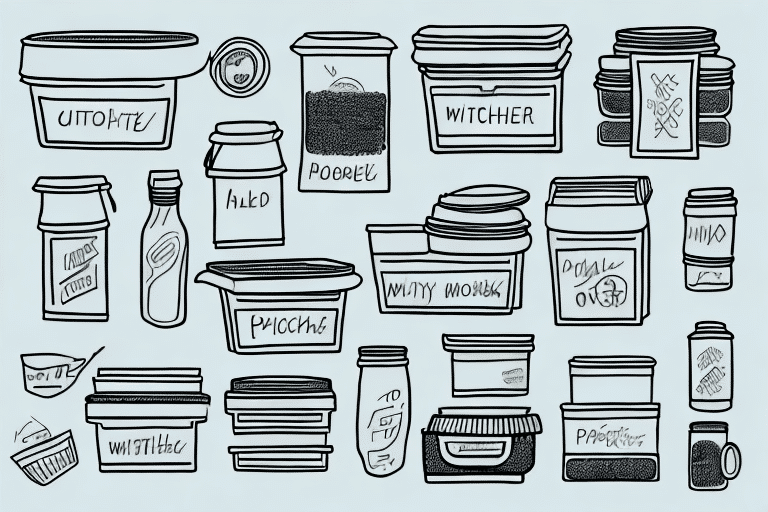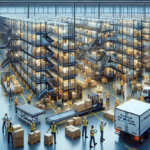Printing Postage and Shipping Labels Made Easy for Busy Meal Preppers
As a busy meal prepper, one of the most time-consuming and tedious tasks can be printing postage and shipping labels for your meal prep containers. However, this process can be streamlined and made efficient with the right tools and techniques. In this article, we will provide an in-depth analysis of how to simplify the process of printing postage and shipping labels, ensuring that your meals are delivered on time, every time.
The Convenience of Meal Prepping
Meal prepping offers a myriad of benefits that can significantly enhance your daily routine. By dedicating a few hours each week to plan, prepare, and portion your meals, you can enjoy nutritious and delicious dishes all week long without the hassle of cooking every day. According to a 2022 NPD report, over 50% of consumers have adopted meal prepping as a regular practice to save time and reduce stress.
Tips for Making Meal Prep Easier and More Efficient
- Plan your meals ahead of time
- Invest in high-quality meal prep containers
- Buy ingredients in bulk to save money
- Label your containers with the date and contents of each meal
- Prepare meals in batches to save time
- Store meals in the freezer or fridge for maximum freshness
Another benefit of meal prepping is that it can help you achieve your health and fitness goals. By planning and preparing your meals in advance, you can ensure that you are consuming the right amount of nutrients and calories to support your fitness routine. Meal prepping can also help you avoid unhealthy snacking and overeating, which can sabotage your weight loss efforts.
Meal prepping can also be a fun and creative activity. You can experiment with different recipes and ingredients, customizing your meals to suit your taste preferences and dietary restrictions. Involving family or friends in the meal prep process can make it a social and enjoyable activity, fostering a sense of community around healthy eating habits.
The Benefits of Buying in Bulk
One of the key advantages of meal prepping is the ability to buy ingredients in bulk and save money. According to the USDA Economic Research Service, purchasing in bulk can reduce the cost per unit by up to 30%. However, to take full advantage of bulk buying, it's important to understand how to store your ingredients properly to maximize their shelf life.
How to Store Bulk Items Properly
- Invest in airtight containers to prevent moisture and air from spoiling your food
- Store dry goods such as rice, beans, and oatmeal in a cool, dry place
- Freeze meat and poultry in individual portions to prevent freezer burn
- Label all of your containers with the date of purchase and the expiration date
Another benefit of buying in bulk is that it can reduce the amount of packaging waste you generate. When you buy smaller quantities of food, you often end up with more packaging per unit of food. By buying in bulk, you can reduce the amount of plastic, cardboard, and other materials that end up in landfills. Additionally, many bulk food stores allow you to bring your own containers, further reducing your environmental impact.
Effective Labeling Strategies for Meal Prep
Efficient labeling is crucial for both meal prepping and shipping your meal prep containers. Proper labeling ensures that your meals are easily identifiable, maintain their freshness, and are shipped correctly. Incorporating effective labeling strategies can save you time and prevent potential errors during the shipping process.
Choosing the Right Label Printing Tools
Selecting the appropriate tools for printing your labels can significantly enhance your efficiency. Consider the following options:
- Thermal Label Printers: Ideal for high-volume printing with minimal maintenance.
- Inkjet Printers: Versatile for various label types but may require more frequent ink replacements.
- Label Design Software: Tools like Canva or Adobe Illustrator can help create professional-looking labels.
Best Practices for Labeling Meal Prep Containers
- Include Essential Information: Date, contents, and any special instructions (e.g., reheating guidelines).
- Use Clear and Legible Fonts: Ensure that all text is easy to read.
- Opt for Durable Materials: Use waterproof and smudge-proof labels to withstand refrigeration and handling.
- Color Code Your Labels: Different colors for different meal types can enhance organization.
Implementing these best practices can streamline your meal prep and shipping processes, ensuring that your meals remain fresh and are easily identifiable upon arrival.
Eating Healthy on a Budget: Tips and Tricks
Eating healthy doesn't have to break the bank. With strategic planning and smart shopping, you can enjoy nutritious meals while staying within your budget.
Affordable Meal Ideas That Won't Break the Bank
- Roasted vegetable quinoa bowls
- Black bean and sweet potato tacos
- Tuna salad lettuce wraps
- Chicken and vegetable stir-fry
- Roasted chicken and vegetable sheet pan dinner
Another effective strategy is to buy in-season produce. Fruits and vegetables that are in season are often cheaper and fresher than those that are out of season. Additionally, consider buying frozen fruits and vegetables, which are often just as nutritious as fresh produce and can be more affordable.
Planning your meals ahead of time and making a grocery list before heading to the store can help you avoid impulse purchases and ensure that you only buy what you need. Finally, consider buying in bulk for items that you use frequently, such as grains, nuts, and seeds. This can be a cost-effective way to stock up on healthy staples.
The Art of Batching: Cooking in Large Quantities
To truly maximize the benefits of meal prepping, embracing the art of batching—cooking large quantities of food at once—is essential. This approach not only saves time but also ensures consistency in your meals.
How to Batch Cook Like a Pro
- Choose recipes that can be easily scaled up or down
- Invest in large pots, pans, and baking sheets
- Utilize your oven and slow cooker to cook large quantities of food simultaneously
- Store your batches of food in individual containers for easy portion control
Batch cooking allows you to take advantage of sales and discounts by buying ingredients in bulk and cooking in large quantities. Additionally, it helps reduce food waste by using up ingredients before they go bad, making it both a practical and eco-friendly choice.
Taking Control of Your Diet: Cooking at Home
Cooking your own meals is one of the best ways to take control of your diet and ensure that you're eating healthy, nutritious, and delicious food. This practice not only benefits your health but also offers significant cost savings.
The Importance of Knowing What's in Your Food
By cooking at home, you have a greater understanding of what's going into your meals. This knowledge helps you make healthier food choices and stay on track with your diet and nutrition goals. Additionally, cooking at home allows you to experiment with new ingredients and flavors, enhancing your culinary skills.
Another benefit of cooking at home is cost savings. Eating out or ordering takeout can be expensive, especially if done frequently. By preparing meals at home, you can buy ingredients in bulk, plan your meals ahead of time, and reduce food waste. Making larger portions also means you can have leftovers for lunch or dinner the next day, saving both time and money.
The Handiness of One-Pot Meals
One-pot meals are an excellent option for meal prepping due to their simplicity and minimal cleanup. These meals are easy to prepare, require only one cooking vessel, and can be stored and reheated with ease.
Easy One-Pot Meal Recipes for Busy Weeknights
- Vegetable chili with cornbread
- Lemon garlic chicken and rice
- Beef and vegetable stew
- Spaghetti and meatballs
- Chicken and vegetable curry
One-pot meals are not only convenient but also healthy and nutritious. By incorporating a variety of vegetables, lean proteins, and whole grains, you can create a balanced and satisfying meal. Since you're only using one pot, you can easily control portion sizes and avoid overeating.
Moreover, one-pot meals are versatile and can be customized to your liking. Whether you want to swap beef for ground turkey or tofu or add more spices to your dish, the possibilities are endless. Experimenting with different flavors and ingredients allows you to find your perfect one-pot meal.
Best Practices for Printing Postage and Shipping Labels
Efficiently printing postage and shipping labels is essential for ensuring that your meal prep containers reach their destination safely and on time. Here are some best practices to optimize your labeling process:
Integrating Label Printing into Your Meal Prep Workflow
- Schedule Label Printing: Allocate specific times during your meal prep sessions to print labels, ensuring consistency and efficiency.
- Use Templates: Create and save label templates to streamline the printing process and maintain a uniform appearance.
- Automate Where Possible: Utilize label printing software that can automate data entry and reduce manual errors.
By integrating these practices into your workflow, you can minimize the time spent on labeling and focus more on preparing your meals.
Ensuring Accuracy and Compliance
Accurate labeling is crucial for compliance with shipping regulations and ensuring that your meals are handled correctly during transit. Here are some tips to ensure accuracy:
- Double-check addresses and contact information to prevent delivery errors.
- Include clear instructions for handling, such as "Keep Refrigerated" or "Fragile."
- Use barcode labels for efficient scanning and tracking.
Adhering to these guidelines not only enhances the professionalism of your shipments but also ensures the safety and quality of your meal prep containers during transit.
Conclusion
By following the tips and techniques outlined in this article, you can streamline the process of printing postage and shipping labels for your meal prep containers, ensuring that your food arrives safely and on time. Additionally, embracing meal prep and cooking at home allows you to enjoy healthy, delicious meals while saving time and money. Incorporating effective labeling strategies further enhances the efficiency and professionalism of your meal prepping process.
Furthermore, meal prepping can help reduce food waste. By planning your meals in advance and only buying the necessary ingredients, you can avoid purchasing excess food that may go to waste. This not only saves you money but also helps reduce your environmental impact.
Lastly, meal prepping can also be a fun and creative activity. Experimenting with different recipes and ingredients, and involving your family or friends in the process, can make meal prep a social and enjoyable activity. It fosters a sense of community and shared responsibility towards healthy eating habits.






















